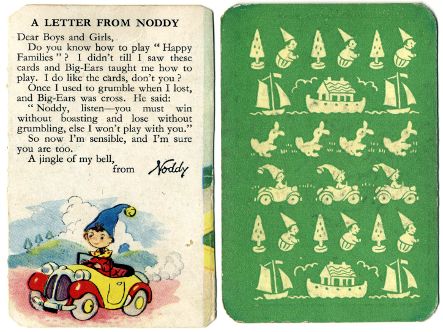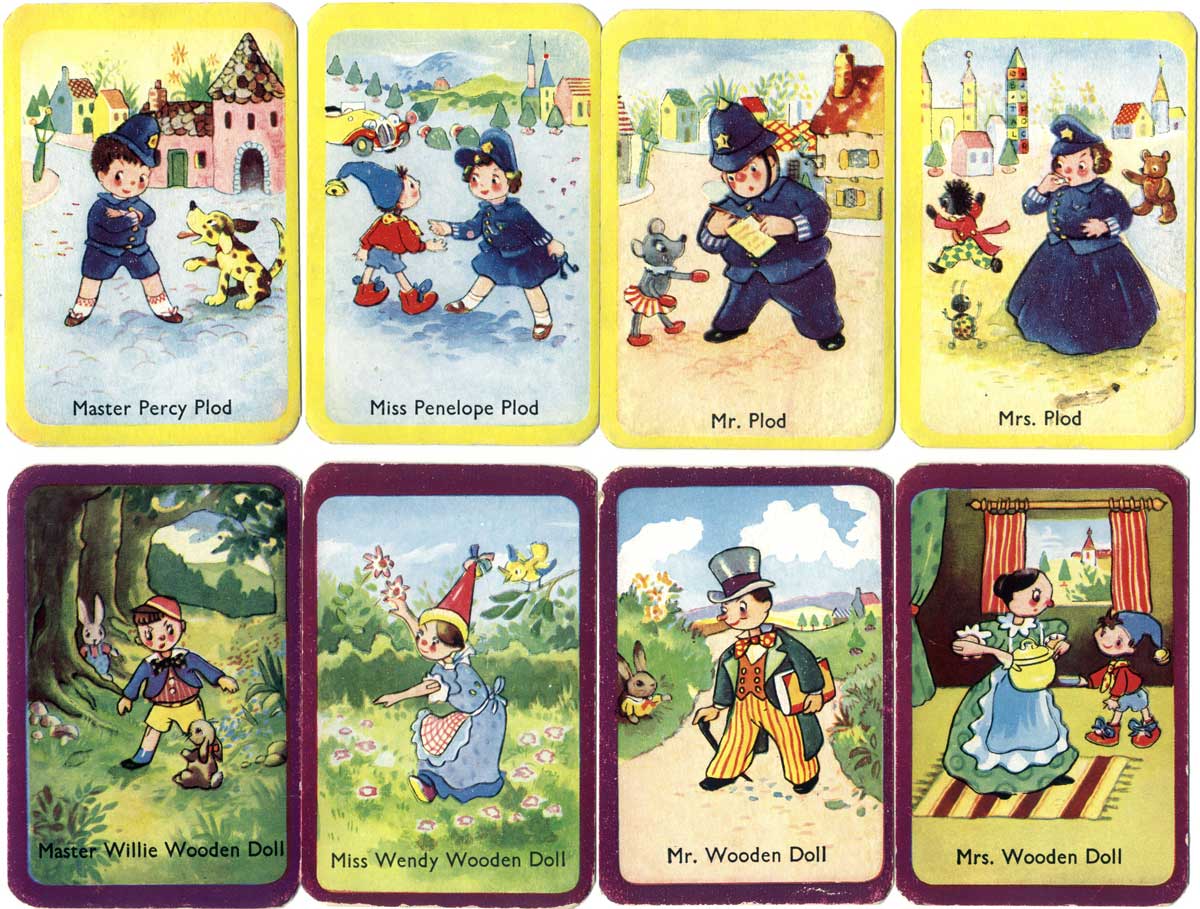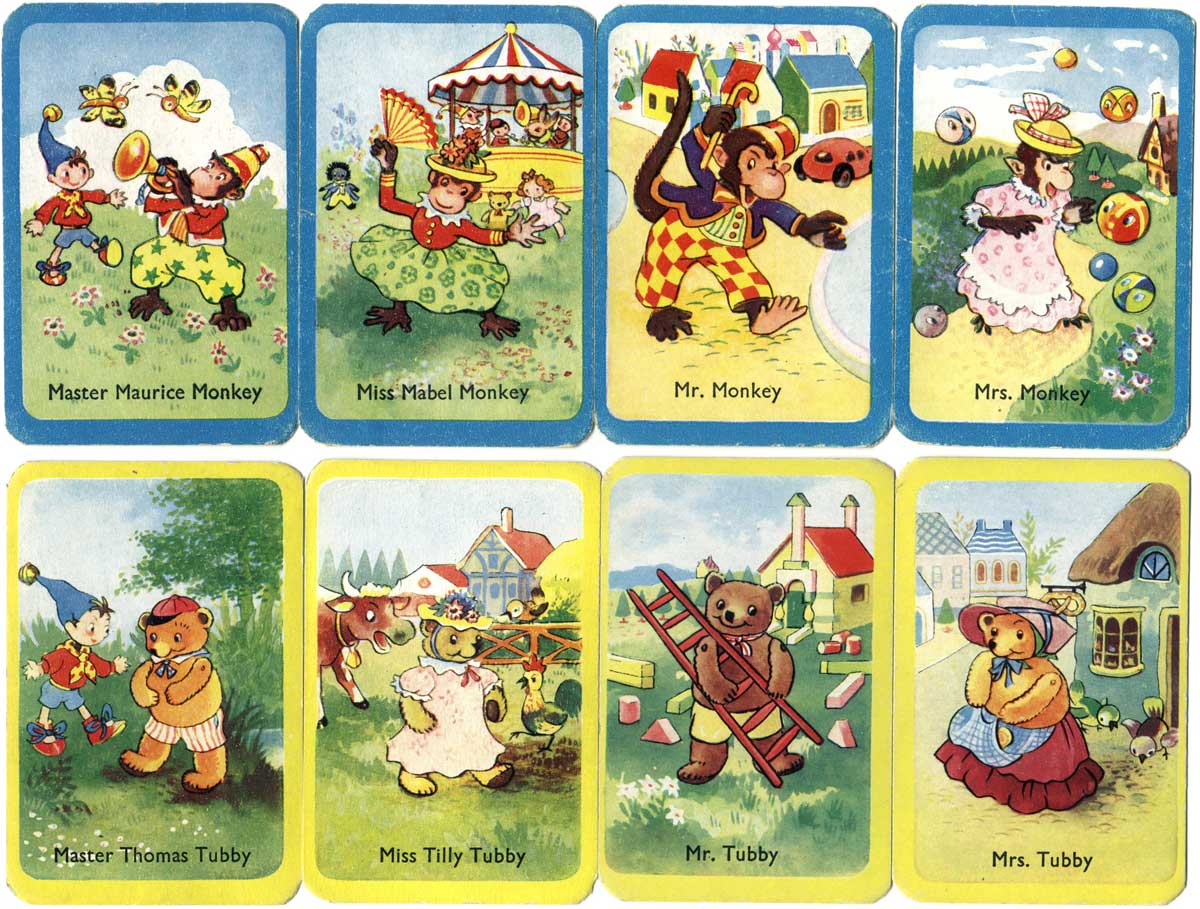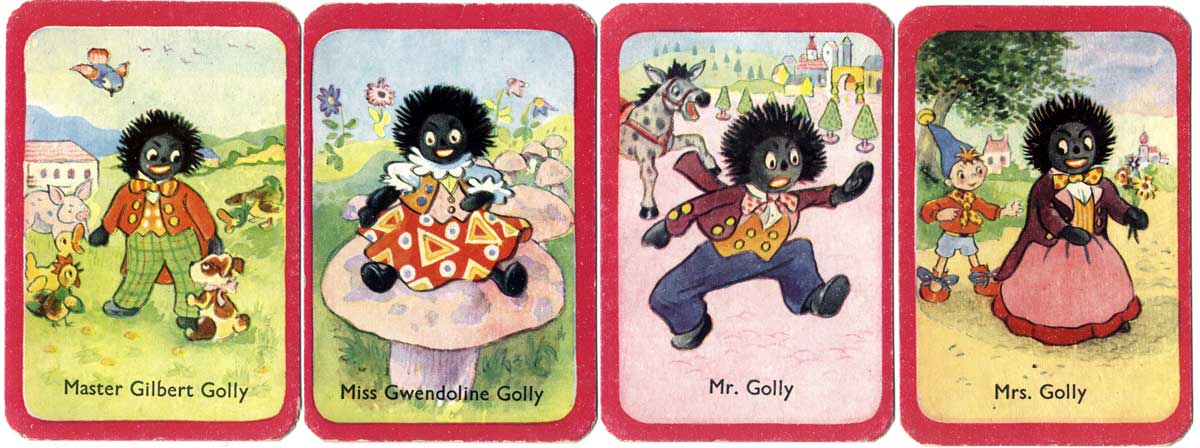Noddy Happy Families
Enid Blyton’s Noddy Happy Families was published in 1955 by Sampson Low, 25 Gilbert Street, London W.1., manufactured in Great Britain.

Enid Blyton’s Noddy Happy Families, 1955
Noddy is a character created by British children's author Enid Blyton, originally published between 1949 and 1963. Television shows based on the character have run on British television since 1955 and continue to appear to this day (see Wikipedia article).
Enid Blyton's Noddy Happy Families card game was published in 1955 by Sampson Low, 25 Gilbert Street, London W.1., manufactured in Great Britain. The illustrations were by Robert Tyndall. Some of the original characters in the Noddy stories are seen today as incorrect or even racist, and attempts have been made to re-write the stories in politically-correct terms. Thus the cards provide documentary evidence of changing attitudes and social stereotypes.

Above-top: Mr Plod is the Toytown policeman. He is a good friend of Noddy and thinks Toytown can't live without him. Mr. Plod is generally long-suffering towards Noddy and Noddy likes Mr. Plod and frequently goes out of his way to help him.

Above: Mr Tubby Bear was Noddy's next door neighbour.

Above: the original Noddy stories featured Golliwogs or black-faced woollen dolls. These dolls were popular in the UK at the time the stories were written, but have fallen out of favour. Mr Golly and his family in the books is the owner of the Toyland garage. He was replaced by the politically correct Mr Sparks in the TV series in the early 1980s.
Early Noddy books have become collectibles, along with other Blytons. The total number is hard to count: the Noddy Library (Sampson Low) of two dozen titles, which became the New Noddy Library when revised, was just part of a big production in the 1950s, with Big Noddy Books of larger format, and strip books. There were numerous spin-offs, such as the playing cards shown on this page.
See also: Famous Five Card Game Happy Families Pekka-Peli Wikipedia Noddy article

By Simon Wintle
Member since February 01, 1996
I am the founder of The World of Playing Cards (est. 1996), a website dedicated to the history, artistry and cultural significance of playing cards and tarot. Over the years I have researched various areas of the subject, acquired and traded collections and contributed as a committee member of the IPCS and graphics editor of The Playing-Card journal. Having lived in Chile, England, Wales, and now Spain, these experiences have shaped my work and passion for playing cards. Amongst my achievements is producing a limited-edition replica of a 17th-century English pack using woodblocks and stencils—a labour of love. Today, the World of Playing Cards is a global collaborative project, with my son Adam serving as the technical driving force behind its development. His innovative efforts have helped shape the site into the thriving hub it is today. You are warmly invited to become a contributor and share your enthusiasm.
Related Articles

Tangle Foot Ale
Badger Brewery Tangle Foot strong ale advertising pack.

Scientific Whist
“Scientific Whist” : standard cards with instructions for play on the faces by Chas Goodall & Son, 1...

Agent Provocateur
Branded lingerie collection in a pack of pin-up playing cards.

Nimbus playing cards
Mike Steer’s weather-themed pack with suits in four colours and backs for cardistry.

Danao Tiāngōng Puke
Children’s playing cards based on the 1961 Chinese animated feature film 大闹天宫 (Havoc in Heaven).

Agatha Christie and Playing Cards revisited
Agatha Christie uses card-play as a primary focus of a story, and as a way of creating plots and mot...

The Decadent Deck
Studies in the eroticism of the female body by Inge Clayton.

Historic Shakespeare
“Historic Shakespeare” playing cards featuring Shakespearean characters by Chas Goodall & Son.

Copechat Paramount Sorting System
Preserving the past: a specimen deck showcasing edge-notched cards and their ingenious sorting syste...

Heartsette by Herbert Fitch & Co, 1893
A glimpse into a busy print and design office in late Victorian London.

Rap Rummy
Rap Rummy made by Parker Brothers in 1926, only 4 years after the discovery of King Tutankhamen’s to...

Batman® playing cards
Batman playing cards published by InterCol of London 1989.

Can You Believe Your Eyes?
“Can You Believe Your Eyes?” playing cards featuring visual illusions & other oddities.

Pastime Playing Cards for the Blind
The “Pastime” Playing Cards for the Blind manufactured by Goodall & Son Limd., c.1910.

Doppel-Deutsche Karten by Bratří Willnerové, Teplice
This deck from local manufacturer Bratří Willnerová offers a standard version of the popular Central...

The European Interchanges Quartets
A card game based around motorway intersections from European countries.
Most Popular
Our top articles from the past 28 days

